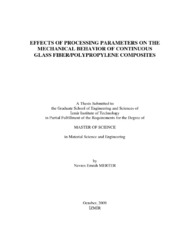Please use this identifier to cite or link to this item:
https://hdl.handle.net/11147/3016Full metadata record
| DC Field | Value | Language |
|---|---|---|
| dc.contributor.advisor | Tanoğlu, Metin | - |
| dc.contributor.author | Merter, Nevres Emrah | - |
| dc.date.accessioned | 2014-07-22T13:50:43Z | - |
| dc.date.available | 2014-07-22T13:50:43Z | - |
| dc.date.issued | 2009 | - |
| dc.identifier.uri | http://hdl.handle.net/11147/3016 | - |
| dc.description | Thesis (Master)--Izmir Institute of Technology, Materials Science and Engineering, Izmir, 2009 | en_US |
| dc.description | Includes bibliographical references (leaves: 78-80) | en_US |
| dc.description | Text in English; Abstract: Turkish and English | en_US |
| dc.description | xii, 80 leaves | en_US |
| dc.description.abstract | Fiber reinforced polymeric composite materials have an increasing demand in industrial applications. Easy and rapid processing capability, high impact and delamination resistance, low moisture absorption and infinite shelf life of the raw materials are the attractive properties of continuous fiber reinforced thermoplastic composite materials. Therefore, thermoplastic based composites find in many application areas in automobile, aerospace, construction, defense, transportation and marine industries. In recent years, hybrid fabrics; composed of continuous glass fibers and polymer fibers such as polypropylene (PP), have been used to fabricate thermoplastic composite with higher fiber volume fraction and improved performance. In this study, hybrid fabrics were developed by commingling the continuous PP and glass fibers using air jet and direct twist hybrid yarn preparation techniques. The hybrid commingled fabrics obtained with 450 fiber orientation and non-crimp fabric pattern. Non-crimp fabrics were obtained various fiber sizing that are compatible and incompatible with PP matrix to investigate the effect of interfacial adhesion on the properties of the thermoplastic composites. Composite panels were produced from these fabrics via hot press compression method. Microstructural properties of the composites were investigated by matrix burn-out test and optical and scanning electron microscopy (SEM) analyzes. Tensile, compression, flexural and interlaminar peel tests were used to investigate the mechanical properties of the composites. Impact properties of the composites were examined by charpy impact test. Results showed that laminates of the fabrics fabricated by air jet hybrid yarn preparation technique exhibit superior properties to those fabricated by direct twist covering hybrid yarn preparation technique. The results also showed that the fabrics with polypropylene compatible sizing results with enhanced composite properties. | en_US |
| dc.language.iso | en | en_US |
| dc.publisher | Izmir Institute of Technology | en_US |
| dc.rights | info:eu-repo/semantics/openAccess | en_US |
| dc.subject.lcc | TA418.9.C6 .M57 2009 | en |
| dc.subject.lcsh | Fibrous composites | en |
| dc.subject.lcsh | Fibrous composites--Impact testing | en |
| dc.subject.lcsh | Composite materials | en |
| dc.subject.lcsh | Thermoplastic composites | en |
| dc.title | Effects of Processing Parameters on the Mechanical Behavior of Continuous Glass Fiber/Polypropylene Composites | en_US |
| dc.type | Master Thesis | en_US |
| dc.institutionauthor | Merter, Nevres Emrah | - |
| dc.department | Thesis (Master)--İzmir Institute of Technology, Materials Science and Engineering | en_US |
| dc.relation.publicationcategory | Tez | en_US |
| dc.identifier.wosquality | N/A | - |
| dc.identifier.scopusquality | N/A | - |
| item.openairecristype | http://purl.org/coar/resource_type/c_18cf | - |
| item.cerifentitytype | Publications | - |
| item.fulltext | With Fulltext | - |
| item.languageiso639-1 | en | - |
| item.grantfulltext | open | - |
| item.openairetype | Master Thesis | - |
| Appears in Collections: | Master Degree / Yüksek Lisans Tezleri | |
Files in This Item:
| File | Description | Size | Format | |
|---|---|---|---|---|
| T000111.pdf | MasterThesis | 6.08 MB | Adobe PDF |  View/Open |
CORE Recommender
Page view(s)
346
checked on Apr 28, 2025
Download(s)
250
checked on Apr 28, 2025
Google ScholarTM
Check
Items in GCRIS Repository are protected by copyright, with all rights reserved, unless otherwise indicated.